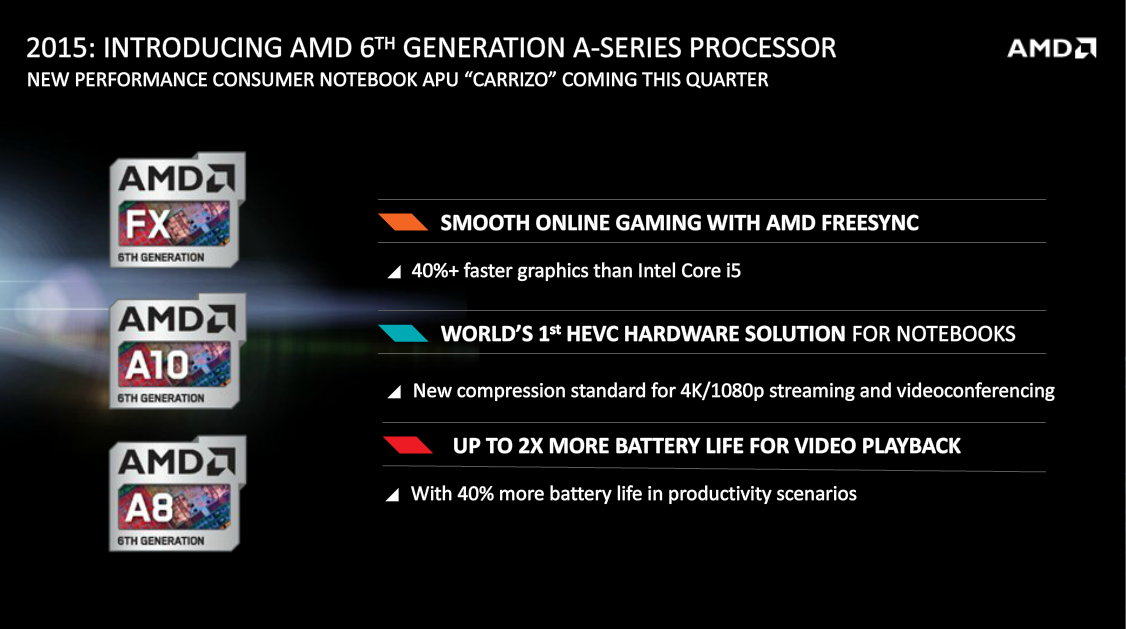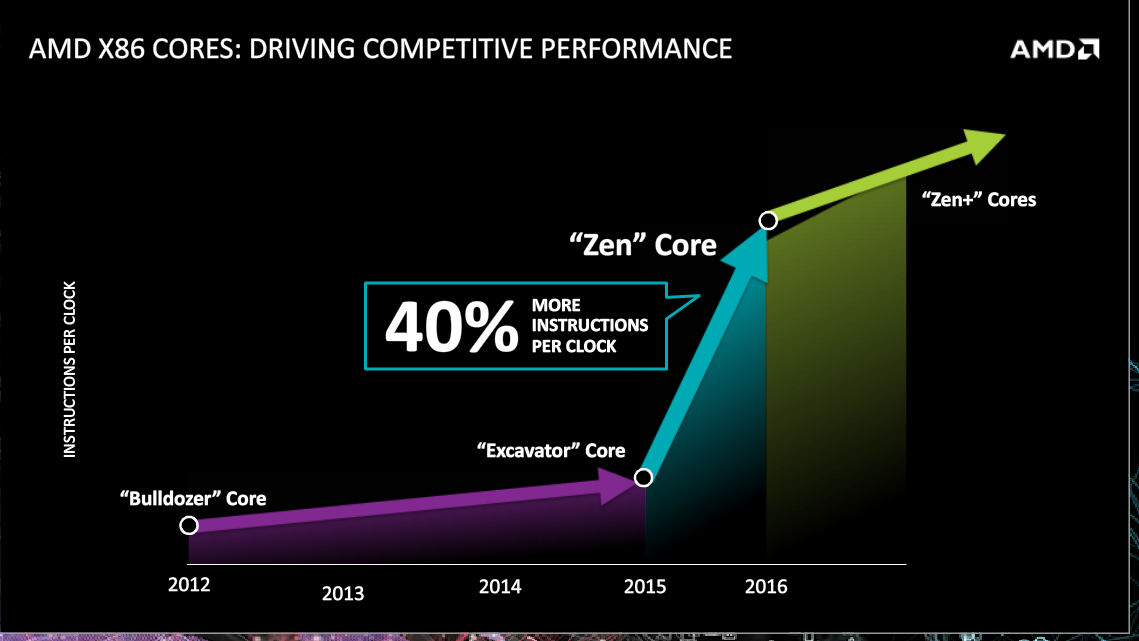AMD Says FX And APU-Based AMD Carrizo Cores Coming Soon
AMD has been hard at work for over a year now on the Excavator CPU architecture known as Carrizo. In a call, AMD said that the new architecture is ready and will be shipping this quarter for both.
The Excavator CPU architecture is the last in AMD's Bulldozer series of architectures. Though we don't know much about the new core yet, we do know that it is based on Bulldozer, and as such we can expect to see a CPU utilizing Clustered Multi-Threading (CMT). In addition, just like the current AMD Kaveri APUs, the chips will be HSA compliant.
AMD didn't give too much information on the new core, but it did say that battery life will increase substantially. AMD expects up to double the battery life for video playback with up to 40 percent more battery life in productivity scenarios.
According to AMD, the APUs will come FreeSync-ready, and they will have 40 percent or greater graphics power than an Intel Core i5. The systems would also use a new compression standard that allows for 4K or 1080p streaming.
Most details about the CPU cores weren't given, but according to a graph, AMD showed an increase in IPC over the previous architecture. Energy efficiency might show greater improvement, as we were previously assured by AMD that a 40 percent power drop is expected from Carrizo compared to Steamroller.
AMD didn't say much about the GPU used in the APU, either. Hopefully, the iGPU will use the same architecture AMD R9 300 series currently under development, but it's possible that the system will continue to use the older architecture found inside of current AMD GPUs.
If AMD's strategy works out, however, Carrizo will be short-lived. AMD's road map shows that 7th Gen APUs will replace Carrizo next year. AMD hasn't said which core type will replace Carrizo, but AMD has been working on a new series of CPU cores designed from the ground up, also codenamed "Zen." This core is expected to be released in 2016 also, and ostensibly offers much greater performance.
Get Tom's Hardware's best news and in-depth reviews, straight to your inbox.
The new chips will be available in AMD's FX and A-series APU lines, and will be notebook SKUs.
Ed. note: A previous version of this article had a critical error. We pulled it, heavily revised it, and are now re-posting.
Follow Michael Justin Allen Sexton @LordLao74. Follow us @tomshardware, on Facebook and on Google+.
-
Calculatron I guess, over in Europe, there already had FX-named FM2/FM2+ based chips: The FX-670K and the FX-770K. These were basically the equivalent of the Athlon X4's, and were Richland (former) and Streamroller (latter) based chips. Most curious!Reply
Anyway, I think it is interesting that all chatter of Samsung potentially purchasing AMD has been thrown out the window with the release of this news. -
de5_Roy nice job, guys.Reply
the i5 mentioned in amd slides is actually a mobile core i5, -U series. since carrizo is also for laptops, the comparison makes sense.. sorta.
the igpu is very interesting. love the HEVC support. i think amd will be the first to launch an HEVC capable processor ahead of intel. in small form factor pcs, carrizo will make a good contender. -
A_J_S_B What a messed up article...40% IPC increase is for 2016 new Zen FX CPU and a bit later for the Zen APU both in socket AM4, all of them in 14 or 16 FinFET.Reply
Carrizo is old tech refined to the limit and only for Notebooks and won't have ANYTHING even close BY FAR of 40% IPC increase. -
razor512 Boasting about being 40% faster graphics than the core i5, is like being happy that the car some shady person sold you, is able to go 40% faster than a turtle. It is still slow and useless.Reply
The current integrated GPU's are more than enough for basic use (in addition to 1080p and 4K video). For gaming, they all fall short, and a 40% improvement will still not be enough. The customer will still have to buy a dedicated GPU if they want a good gaming experience (unless all they want to do is play 2D platformers or card games).
For desktop, get rid of the GPU and use that space for more cores. For mobile, use the extra GPU power to make the GPU smaller but keep the same performance, and then use the extra space for probably 1 extra core. -
Quixit ReplyBoasting about being 40% faster graphics than the core i5, is like being happy that the car some shady person sold you, is able to go 40% faster than a turtle. It is still slow and useless.
The current integrated GPU's are more than enough for basic use (in addition to 1080p and 4K video). For gaming, they all fall short, and a 40% improvement will still not be enough. The customer will still have to buy a dedicated GPU if they want a good gaming experience (unless all they want to do is play 2D platformers or card games).
For desktop, get rid of the GPU and use that space for more cores. For mobile, use the extra GPU power to make the GPU smaller but keep the same performance, and then use the extra space for probably 1 extra core.
I don't know about that. I think it's more like bragging that you're 40% faster in a foot race than a man with no legs. -
Lordos Is there really going to be update for FX series? This is only site I could see to state such possibility. Is there any other source for this info other then above APU slide? Cause apart of FX logo there is not a single reference to it.Reply
Also doesn't the FX have only 2 generations (Zanbezi & Vishera) so why they say 6th generation?
Last weeks I'm seriously thinking about upgrade for my PC and I'm almost ready to pull the trigger for 8320E Vishera but now I'm not so sure if new FX should come. -
de5_Roy Reply
amd has been using FX brand for it's top mobile apus since kaveri launch. amd will update desktop FX cpus in 2016 with zen cores and AM4 socket.15819246 said:Is there really going to be update for FX series? This is only site I could see to state such possibility. Is there any other source for this info other then above APU slide? Cause apart of FX logo there is not a single reference to it.
Also doesn't the FX have only 2 generations (Zanbezi & Vishera) so why they say 6th generation?
Last weeks I'm seriously thinking about upgrade for my PC and I'm almost ready to pull the trigger for 8320E Vishera but now I'm not so sure if new FX should come.
6th generation apu is refered to upcoming carrizo apus. it's a marketing term to mimic intel's "8th generation graphics" and "5th generation core processors" shenanigans. apparently sales people love saying "generation".
-
Lordos Replyamd has been using FX brand for it's top mobile apus since kaveri launch. amd will update desktop FX cpus in 2016 with zen cores and AM4 socket.
Yeah that's what I knew so far, that nothing new for FX this year, while Zen and AM4 coming 2016. So thanks for clarification, didn't know they used FX for something else than desktop CPUs, that's what confused me :)
6th generation apu is refered to upcoming carrizo apus. it's a marketing term to mimic intel's "8th generation graphics" and "5th generation core processors" shenanigans. apparently sales people love saying "generation".
So I will then probably go ahead for 8320e as my old C2D is getting really old and cant wait much longer for Zen.

